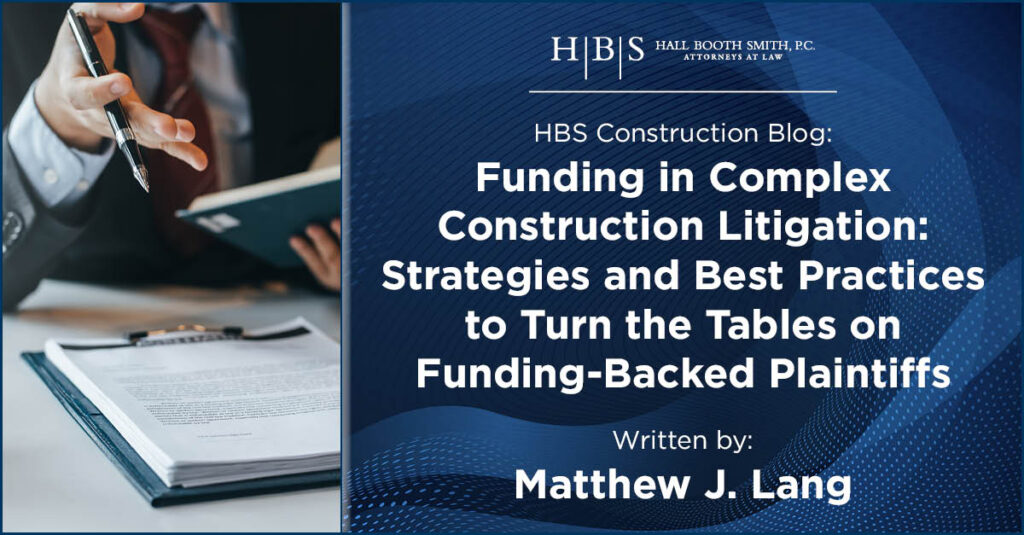
Funding in Complex Construction Litigation: Strategies and Best Practices to Turn the Tables on Funding-Backed Plaintiffs

Written by: Matthew J. Lang, Esq.
Background
Litigation funding is not new. Since litigation funding was conceived, it has been a proverbial thorn in the sides of defense attorneys and insurance adjusters. Those defense attorneys and adjusters who have handled cases involving outsourced funding know that litigation funding makes cases extremely difficult to settle. When those cases do settle, they settle for outsized amounts.
When plaintiffs or plaintiffs’ firms seek out funding to cover legal, remedial, or medical expenses before a case is resolved, they necessarily increase the bottom line for which they are willing and able to settle with defendants. Some litigation funding organizations have input and in fact a veto over any settlement that would not enable them to recoup expenses. [1] Interest rates attached to litigation loans are often incredibly high.
In complex litigation, this issue is compounded, since defendants and adjusters often have a multitude of intersecting and conflicting interests to navigate prior to reaching settlement.
Further, in many jurisdictions, insurance companies are placed in a bind when presented with a policy limit settlement offer from a plaintiff. If accepted, a policy limit is paid out in full. If a policy limit offer is rejected and later an insured is found to be liable for damages in excess of a policy limit, an insurer would be liable for the policy limit in addition to any excess amount awarded to a plaintiff.[2]
Complex Litigation Issues & Mediation
To avoid the issues and expenses associated with complex litigation involving litigation funding, many defense attorneys, very aptly, seek to mediate claims early in litigation. Disclosures made before mediation will often contain information concerning policy limits. In some jurisdictions, defendants are required to disclose this information shortly after receipt of a summons.[3]
However, once that information is known to Plaintiffs, there is nothing in place to stop plaintiffs from making a policy limit demand early, before necessary discovery is conducted. In complex cases involving multiple parties, and where liability can often be shifted to other entities discovered to be at fault during investigations, premature resolution of a matter in favor of avoiding the threat of excess liability following a policy limit demand, could lead to unjust results, where parties with little to no actual liability, or whose liability is unknown, are strong-armed into settlement to avoid the possibility of outsized liability attaching to those parties.
In the absence of legislative action curbing the influence litigation funding organizations have both directly and indirectly, what strategies can be implemented to avoid these pitfalls?
Many of the tactics and strategies already used by defense attorneys can be used to mitigate the risks described above. However, these strategies take on new significance in the context of cases involving litigation funding, and the issues associated there with.
Strategies
First, defense attorneys need information concerning the source and amount of litigation funding. This information should be sought and–hopefully–obtained early and supplemented often. Absent information concerning the presence, source, and amount of funding, defense attorneys and their clients are placed at a disadvantage in defending cases. Defense attorneys may need to be creative in order to obtain this information. If Plaintiffs are hesitant to provide this information voluntarily, filing subpoenas, or pursuing public records requests for liens on forthcoming judgments may be required. Ultimately, defense attorneys and adjusters need to develop and implement a plan early in litigation to obtain this information.
Second, defense attorneys should work with their clients and adjusters to set a narrative early in litigation. Retaining experts, conducting inspections, evaluations, and investigations, and obtaining admissions, in an attempt to limit exposure to an insured and an insurer as soon as practicable, are all best practices that should be utilized.
Third, armed with information obtained from the sources described above, defense attorneys should aggressively pursue early mediation. Assuming a strong narrative is in place, even upon receipt of a policy limit demand, early mediation may reduce the risks associated with continued litigation. An experienced and respected mediator will likely be able to balance and weigh the presence of litigation funding, a strong defense narrative, and a policy limit demand, to foster a favorable resolution, especially where a litigation funder does not have a veto over a settlement.
Finally, defense attorneys have tools to transfer the risk of cost to a plaintiff. Frivolous litigation dismissal demands are commonplace in some jurisdictions and should be pursued. Additionally, attorneys should diligently and efficiently pursue discovery, including deposing key witnesses. While attorneys should undoubtedly extend professional courtesies in this context, when discovery demands seeking vital information are ignored, attorneys should not shy away from motion practice.
If all else fails, attorneys should be prepared to aggressively argue damages at trial. In a case where liability is clear but damages are not, and a policy limit demand and/or the presence of litigation funding prevented settlement, developing a strong damages case for trial may be an attorney’s best option.
Conclusion
Ultimately, legislative action is needed to regulate the litigation funding industry. Action should be taken to curb interest rates charged, set standards for repayment of funds upon resolution, prevent monopolization of the industry, and craft and enforce ethical rules concerning both settlement control and the appropriate amount of communication between a plaintiff’s attorney and funding provider.
A justification can be conceived for legislatively increasing access to information concerning insurance policies in litigation. However, there is no justification for completely failing to regulate the litigation funding industry. This double standard has caused the issues discussed above, and undoubtedly others. Until regulations are established though, defense attorneys should utilize the strategies discussed above to mitigate the issues associated with litigation funding and rules concerning policy limit settlement demands.
Footnotes
1. Many examples of litigation funding agreements can be found online. See the U.S. Securities and Exchange Commission site for one such example.
2. GEICO Indemnity Company v. Whiteside, 311 Ga. 346 (Ga., 2021); Register v. White, 358 N.C. 691 (N.C.,2004); Doe v. South Carolina Medical Malpractice Liability Joint Underwriting Ass’n, 347 S.C. 642 (S.C.,2001); Rova Farms Resort, Inc. v. Investors Ins. Co. of America, 65 N.J. 474 (N.J. 1974).
3. N.J. Rule 4:103-1 – Initial Disclosures; New York CPLR 3101(f).
Disclaimer
This material is provided for informational purposes only. It is not intended to constitute legal advice nor does it create a client-lawyer relationship between Hall Booth Smith, P.C. and any recipient. Recipients should consult with counsel before taking any actions based on the information contained within this material. This material may be considered attorney advertising in some jurisdictions. Prior results do not guarantee a similar outcome.


Leave a comment
You must be logged in to post a comment.